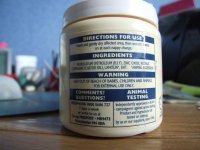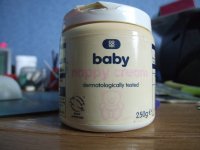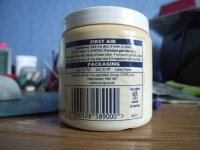<snip>Also, silicone heat sink goop has a strange affinity for dark clothing - beware. <snip>
Reassuring to hear I am not the only one victimized by this "strange affinity.."
It depends on the filler. Older ones with beryllium oxide ought to be approached with caution. Newer ones with zinc oxide are pretty safe, but I'd still wash my hands after using. The silicone itself is pretty nonhazardous.
By older, about how old do you mean? 80s? 70s?
Reassuring to hear I am not the only one victimized by this "strange affinity.."
We wear black long sleeved jackets at work as part of the uniform. One time, I put my arm on top of a computer CPU. And surprisingly, someone left a heatsink full of goop on it.
We were still using BeO pads enthusiastically in the early '80s but they disappeared in a hurry around 1983, IIRC.Good question and I don't know when there was a changeover. I'd suspect '70s, but that's just guessing.
Such government led safety measures tend to spread pretty quickly from the first country of introduction. It's one of the few things regulators do promptly so I guess things were similar elsewhere.
The initial objection to BeO was the massive levels of inhaled dust in preparing the substance, the ceramics manufacture and handling the various moulded and ground sheet products. Dispersed in a silicone oil, you would not have the concern of dust exposure until later when the oil oozed out and migrated across surfaces as it loves to do. Handling the cheesy gunk remaining would then be some hazard for repairmen and you can well expect, for DIYs like us who like to refurbish old gear.
I'd say be real careful with how you remove and clean up the grease remains of electronics built or repaired before 1990. Use wet methods rather than dry to suppress dust and fragments spreading around. I have a couple of Mosfet amps from 79-82 that still use the ceramic pads, They won't blow, so I won't need to touch them - just as I prefer!
No one has mentioned, and I do not know, HOW the stuff is toxic. For example, the lead in our solder is toxic, but you have to injest it. Just handling the lead has a very low danger. DOn't stick it in your mouth.
heat grease, aside from not bathing in it, is it absorbed through the skin? Or would we have to injest that too?
Things that are outlawed may or may not be so designated for reasons of direct peril. As seemed suggested in an above post, they may outlaw it because it is toxic to people making it rather than the users.
I am convinced that if you work with the stuff without getting it all over you, you must be doing it wrong. How many times must I reach for a heat sink and... EWWWWW.
heat grease, aside from not bathing in it, is it absorbed through the skin? Or would we have to injest that too?
Things that are outlawed may or may not be so designated for reasons of direct peril. As seemed suggested in an above post, they may outlaw it because it is toxic to people making it rather than the users.
I am convinced that if you work with the stuff without getting it all over you, you must be doing it wrong. How many times must I reach for a heat sink and... EWWWWW.
I am convinced that if you work with the stuff without getting it all over you, you must be doing it wrong. How many times must I reach for a heat sink and... EWWWWW.
Yes! And for some reason my palm or finger(s) always land on the part with the most grease.
Skin contact with BeO can produce an allergic reaction. No inhalation is necessary - though that is far worse.No one has mentioned, and I do not know, HOW the stuff is toxic. For example, the lead in our solder is toxic, but you have to injest it. Just handling the lead has a very low danger. DOn't stick it in your mouth.
heat grease, aside from not bathing in it, is it absorbed through the skin? Or would we have to injest that too?
Things that are outlawed may or may not be so designated for reasons of direct peril. As seemed suggested in an above post, they may outlaw it because it is toxic to people making it rather than the users.
I am convinced that if you work with the stuff without getting it all over you, you must be doing it wrong. How many times must I reach for a heat sink and... EWWWWW.
Recently I took apart a "Kenford" car amplifier with the idea of using the case/heat sink for a project. The label said "MOSFET" but that was just the inverter used to generate a higher rail voltage for the amp. There was about half a dozen things (the mentioned mosfets, four output BJT's and apparently two diodes) mounted to the case/heat sink with the usual compound. I don't suppose there's an easy (and "non-destructive" to living animals) way to test for what it's made of, is there? I did try to avoid the compound as much as reasonable, and washed my hands afterward, but I hadn't heard of heatsink compound containing beryllium. If I had and thought this might have that in it, I wouldn't have opened it up.
I recall a Heathkit transmitter uses a whole solid BLOCK of beryllium for a heat sink/heat conductor to a heat sink, and sure enough there's something on the web saying the original assembly manual tells what to do for safety if the block ever cracks, and warns against sanding or drilling it, etc. I found this thread:
http://forums.qrz.com/showthread.php?251844-Beryllium-Oxide-poisoning
I only read the first two pages of the thread, that much is scary enough.
With lead-bearing solder it's strongly suggested that you wash your hands after handling it. And if you ever use lead paste for SMT soldering, I've read where that stuff can be nasty because of how easily it can be ingested if it gets on your fingers.
I recall a Heathkit transmitter uses a whole solid BLOCK of beryllium for a heat sink/heat conductor to a heat sink, and sure enough there's something on the web saying the original assembly manual tells what to do for safety if the block ever cracks, and warns against sanding or drilling it, etc. I found this thread:
http://forums.qrz.com/showthread.php?251844-Beryllium-Oxide-poisoning
I only read the first two pages of the thread, that much is scary enough.
With lead-bearing solder it's strongly suggested that you wash your hands after handling it. And if you ever use lead paste for SMT soldering, I've read where that stuff can be nasty because of how easily it can be ingested if it gets on your fingers.
Exactly, As indicated earlier, BeO was banned back then as it became the preferred way to get highest dissipation as a pad for flat devices or compounded as a grease.
Before and since then, cheaper greases using ZnO and a few slightly higher conduction compounds (see Wikipedia) have been used. The first greases varied but most were the same as the clear laboratory glass joint grease or "stopcock grease" which is also silicone oil and sub-micron particle silicon dioxide aerogel. 'Amazing stuff and highly dangerous dust. Agoin, non poisonous but toxic because of the fine particle size leading to silicosis etc.
The thing to note about hazardous dusts is, they can be rendered safe as long as they remain wetted as a stable grease or paste. Compounds that harden, dry out or separate, may return to their dust state and perhaps become a problem if they are actually toxic. The plan has been not to serve up potentially dangerous compounds for use in consumer or commercial equipment where anyone is likely to mess with them. Yet you can still expect problems with non-consumer equipment where high-reliability and ultimate performance are paramount. (aerospace, military, sealed safety devices etc.
In case you get paranoid about anything that has a chemical name, the ZnO is also the high-spf sunblock and a pharmaceutical base. Now silicones..hmm prosthetics, water resistant fabric treatment, lotions, wound dressings...we actually use a lot of this stuff and it's a real nuisance - spreads everywhere, hard to remove or wash but not directly toxic.
Most confusion here is about the time scale of industry changes and usually, hearsay facts become a jumble that sounds like scaremongering if you don't put them in order and perspective. There is not much of a problem for us if we stay with routine products. In fact, what I make is so routine anyone can make it from Dow Oil and fine grade ZnO. Stirred, not shaken! It's ultra-cheap and will like;y see me out for the amount DIYs would ever need.
Soldering is an interesting study, Enzo. I worked in a plant that once made Stackpole process resistors and tinning was everywhere. Then the line stopped and automotive brushes and contacts were made and the lead blood levels became far worse for QC workers than operators because they handled the parts, the solder and the raw materials whereas the operators just breathed the vapour and flux. I dare say a lot of manufacturing techs would have a bit to say on that subject
Before and since then, cheaper greases using ZnO and a few slightly higher conduction compounds (see Wikipedia) have been used. The first greases varied but most were the same as the clear laboratory glass joint grease or "stopcock grease" which is also silicone oil and sub-micron particle silicon dioxide aerogel. 'Amazing stuff and highly dangerous dust. Agoin, non poisonous but toxic because of the fine particle size leading to silicosis etc.
The thing to note about hazardous dusts is, they can be rendered safe as long as they remain wetted as a stable grease or paste. Compounds that harden, dry out or separate, may return to their dust state and perhaps become a problem if they are actually toxic. The plan has been not to serve up potentially dangerous compounds for use in consumer or commercial equipment where anyone is likely to mess with them. Yet you can still expect problems with non-consumer equipment where high-reliability and ultimate performance are paramount. (aerospace, military, sealed safety devices etc.
In case you get paranoid about anything that has a chemical name, the ZnO is also the high-spf sunblock and a pharmaceutical base. Now silicones..hmm prosthetics, water resistant fabric treatment, lotions, wound dressings...we actually use a lot of this stuff and it's a real nuisance - spreads everywhere, hard to remove or wash but not directly toxic.
Most confusion here is about the time scale of industry changes and usually, hearsay facts become a jumble that sounds like scaremongering if you don't put them in order and perspective. There is not much of a problem for us if we stay with routine products. In fact, what I make is so routine anyone can make it from Dow Oil and fine grade ZnO. Stirred, not shaken! It's ultra-cheap and will like;y see me out for the amount DIYs would ever need.
Soldering is an interesting study, Enzo. I worked in a plant that once made Stackpole process resistors and tinning was everywhere. Then the line stopped and automotive brushes and contacts were made and the lead blood levels became far worse for QC workers than operators because they handled the parts, the solder and the raw materials whereas the operators just breathed the vapour and flux. I dare say a lot of manufacturing techs would have a bit to say on that subject
Wait, are you calling him gay?You better watch out for silicone tits.
- Status
- This old topic is closed. If you want to reopen this topic, contact a moderator using the "Report Post" button.
- Home
- Amplifiers
- Solid State
- Silicon Grease Toxicity


